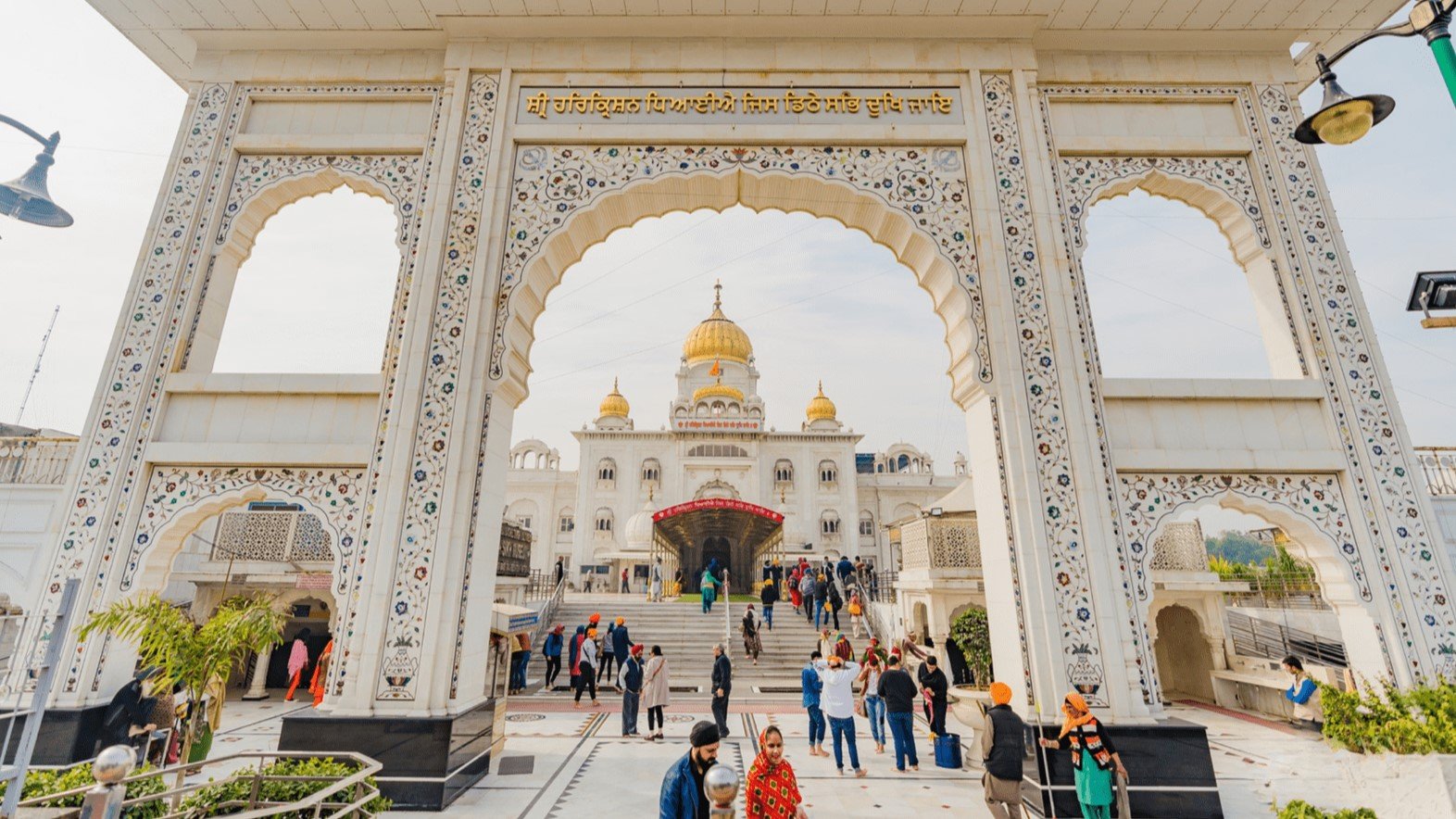Delhi, with its centuries of history, is home to some of the most historically significant and spiritually powerful Sikh temples (Gurudwaras). Each Gurudwara reflects Sikhism’s core values of service, courage, equality, and faith. The journey through these sacred sites offers an opportunity to not only experience Sikh spirituality but also to understand the trials and tribulations faced by the Sikh Gurus and their followers. Delhi is unique as it is the only city that has been visited by five of the ten Sikh Gurus: Guru Nanak Dev Ji, Guru Hargobind Ji, Guru Har Krishan Ji, Guru Teg Bahadur Ji, and Guru Gobind Singh Ji.
Gurudwara Moti Bagh Sahib: The Strength of Guru Gobind Singh Ji
Gurudwara Moti Bagh Sahib, situated in South Delhi, carries a remarkable story of Guru Gobind Singh Ji, the tenth Guru of the Sikhs. Upon his arrival in Delhi in 1707, during the rule of Mughal Emperor Bahadur Shah, Guru Gobind Singh Ji stayed here with his followers.
One day, the Guru, renowned for his skill in archery, demonstrated his ability by shooting an arrow from Moti Bagh to the Red Fort—a significant distance of about 8 kilometres. This demonstration wasn’t just a show of skill but a subtle message of his presence and power, even in the heart of the Mughal Empire. The emperor, impressed by the Guru’s boldness, invited him to the Red Fort. This meeting was crucial in establishing diplomatic relations between the Sikh community and the Mughals during a time of political tension.
Moti Bagh Sahib symbolises the Guru’s mastery not just in warfare, but also in diplomacy. Guru Gobind Singh Ji’s presence in Delhi during this critical time showed the strength of Sikhism, even in the face of one of the most powerful empires of the time. This Gurudwara stands today as a mark of leadership, reminding devotees of the Guru’s skill and courage in times of peace and conflict.
Gurudwara Bangla Sahib: The Legacy of Guru Har Krishan Ji’s Compassion
Gurudwara Bangla Sahib, located near Connaught Place, is one of the most popular tourist destinations in Delhi. This sacred site was once a palace belonging to Raja Jai Singh in the 17th century. It gained significance when Guru Har Krishan Ji, the eighth Guru, stayed here during his visit to Delhi in 1664.
At that time, Delhi was plagued by a severe epidemic of smallpox and cholera. Despite being just a child, Guru Har Krishan Ji devoted his time to healing the sick and comforting the afflicted. The young Guru exemplified Sikhism’s core value of service to humanity. The Guru fell victim to the same illness that he worked tirelessly to fight and ultimately passed away here, sacrificing his own life to serve others.
The water from the Sarovar at Bangla Sahib, believed to have healing powers, has been a source of comfort for the sick for centuries. The well from which Guru Har Krishan Ji provided water to the afflicted continues to draw devotees who believe in the Guru’s power to heal.
Bangla Sahib not only offers spiritual solace but also exemplifies the spirit of Sikhism—selfless service without seeking anything in return. The continuous Langar (community kitchen) served here is a reminder of the Sikh tenet that feeding the hungry is one of the highest forms of service. The historical significance of Bangla Sahib lies in its embodiment of compassion, a value central to Sikhism, as seen through the actions of Guru Har Krishan Ji.
Gurudwara Sis Ganj Sahib: A Monument of Martyrdom and Courage
Gurudwara Sis Ganj Sahib holds a deep and painful history that forms a cornerstone of Sikh identity. Located in Chandni Chowk, Old Delhi, it is the site where Guru Tegh Bahadur Ji, the ninth Guru of the Sikhs, was executed on the orders of Mughal Emperor Aurangzeb in 1675. This was no ordinary death; Guru Tegh Bahadur Ji’s martyrdom was a stand for the religious rights of Kashmiri Pandits, who were being forced to convert to Islam by the Mughal regim
e.
Refusing to submit to Aurangzeb’s demands, Guru Tegh Bahadur Ji chose death over compromising his faith. His sacrifice was not just for the Sikh community but for the broader principle of freedom of religion, a fundamental belief in Sikhism. The site of his execution became a shrine that commemorates his martyrdom, standing as a powerful reminder of the Guru’s courage and commitment to protecting the oppressed.
Beneath a tree, Guru Tegh Bahadur Ji was publicly beheaded, and Bhai Jaita, a devoted Sikh, courageously recovered the Guru’s head, carrying it all the way to Anandpur Sahib for a dignified cremation. The name “Sis Ganj” directly refers to this act, with “Sis” meaning head. Sis Ganj Sahib therefore marks not only the martyrdom of Guru Tegh Bahadur Ji but also the brave efforts of his followers in preserving his legacy.
This Gurudwara plays a significant role in Sikh history, representing sacrifice, defiance against tyranny, and the importance of standing up for justice. Visitors to Sis Ganj Sahib are reminded of the high cost of religious freedom and the unwavering resolve of Sikh Gurus in the face of oppression.
Gurudwara Rakab Ganj Sahib: A Story of Loyalty and Devotion
Gurudwara Rakab Ganj Sahib, located near Parliament House, has a deep connection to the martyrdom of Guru Tegh Bahadur Ji, making it closely related to Gurudwara Sis Ganj Sahib. After Guru Tegh Bahadur Ji was executed, his body was left in the open at Chandni Chowk as a warning to others who would resist the Mughal regime. Bhai Lakhi Shah Vanjara, a Sikh trader and a devoted follower, undertook the dangerous mission of retrieving the Guru’s body.
Bhai Lakhi Shah Vanjara transported the body secretly to his home, which was at the present-day site of Rakab Ganj Sahib. To ensure that Guru Tegh Bahadur Ji’s body was cremated with dignity, Bhai Lakhi Shah Vanjara set his home on fire, disguising the cremation as part of the blaze. This act of bravery, despite the risks involved, ensured that the Guru’s body received the respect it deserved.
Rakab Ganj Sahib serves as a testament to the devotion and loyalty of Sikhs to their Gurus. It highlights the lengths to which Sikh followers were willing to go to preserve the honour and dignity of their faith, even in the face of extreme danger. Rakab Ganj Sahib and Sis Ganj Sahib together tell a complete story of Guru Tegh Bahadur Ji’s ultimate sacrifice for religious freedom and the unwavering loyalty of his followers.
Gurudwara Majnu Ka Tila: The Meeting of Guru Nanak Dev Ji and Devotion
Gurudwara Majnu Ka Tila, located on the banks of the Yamuna River, derives its name from a Sufi saint named Majnu during the reign of Sikander Lodi. It is said that Majnu, a devout man, spent his life ferrying passengers across the Yamuna while lost in his spiritual longing for divine connection.
When Guru Nanak Dev Ji, the founder of Sikhism, visited this spot during his travels, he blessed Majnu for his unwavering devotion. Over time, this place became a shrine where people of all faiths came to seek blessings and guidance. Later, Guru Hargobind Ji, the sixth Guru of the Sikhs, also visited Majnu Ka Tila, enhancing its significance in Sikh history.
Guru Hargobind Ji, on his way to Delhi after being released from imprisonment in Gwalior Fort, stopped here, further establishing Majnu Ka Tila as a site blessed by the Sikh Gurus. The Gurudwara’s history, enriched by the presence of two Gurus, makes it a unique and important site for Sikhs. It stands as a symbol of spiritual longing and the meeting of two great spiritual figures—Majnu, the Sufi, and Guru Nanak Dev Ji, the Sikh Guru.
Majnu Ka Tila is a place of reflection, where visitors can contemplate the power of devotion and the deep connection between humanity and the divine. It also serves as a reminder of how Sikhism embraces all forms of devotion and spirituality, regardless of faith.
Gurudwara Bala Sahib: The Resting Place of Sikh Leaders
Gurudwara Bala Sahib is located in near the banks of Yamuna and holds immense significance for being the cremation site of Guru Har Krishan Ji, the eighth Guru of the Sikhs. After serving the people of Delhi during the smallpox epidemic, Guru Har Krishan Ji succumbed to the illness and was cremated at this spot.
In addition to being the final resting place of Guru Har Krishan Ji, this Gurudwara also contains the (memorials) of Mata Sundri Ji and Mata Sahib Kaur Ji. Mata Sundri Ji, the wife of Guru Gobind Singh Ji, played a crucial role in guiding the Sikh community after the Guru’s passing, while Mata Sahib Kaur Ji is revered as the Mother of the Khalsa.
Gurudwara Bala Sahib serves as a tribute not only to Guru Har Krishan Ji but also to the powerful women in Sikh history who helped shape and preserve Sikhism during times of great challenge. It is a place of reflection on the sacrifices made by both the Gurus and their families.
Gurudwara Nanak Piao Sahib: A Well of Kindness and Equality
Gurudwara Nanak Piao Sahib, located in the northern part of Delhi, commemorates Guru Nanak Dev Ji’s stay in the city during one of his many travels. The word “Piao” means to serve or offer. Guru Nanak Dev Ji set up camp in the garden, and as people gathered to hear his teachings, he offered food and water to all, no matter their religion or social status
The well from which Guru Nanak Dev Ji drew water to serve travellers still exists at the site. This act of service was a powerful statement against the caste system that divided society at the time. Over time, the garden where Guru Nanak Dev Ji stayed and served people became known as Nanak Piao, symbolising the Guru’s offering of sustenance and compassion. Later, a Gurudwara was built on this site to honour Guru Nanak Dev Ji’s visit and his teachings.
For anyone visiting Delhi, a trip to Gurudwara Nanak Piao Sahib is not just a spiritual journey but a lesson in humanity and selfless service. This Gurudwara serves as a bridge between the past and present, linking Guru Nanak Dev Ji’s timeless values with the challenges of the modern world.
A Journey Through Sikh Heritage
Delhi’s Gurudwaras offer a connection to Sikh history and values. Each Gurudwara tells a unique story of courage, devotion, and service, from the martyrdom of Guru Tegh Bahadur Ji at Sis Ganj Sahib to the healing touch of Guru Har Krishan Ji at Bangla Sahib. Visiting these sacred sites allows devotees and visitors alike to walk in the footsteps of the Sikh Gurus and their followers, experiencing firsthand the history and spirituality that shaped Sikhism.
The Delhi Sikh Yatra is not just a spiritual yatra; it is an exploration of the very foundation of Sikh values—selflessness, equality, resilience, and unwavering faith in the face of adversity. Each Gurudwara serves as a chapter in the rich sikh history, inviting all who visit to learn, reflect, and be inspired.










